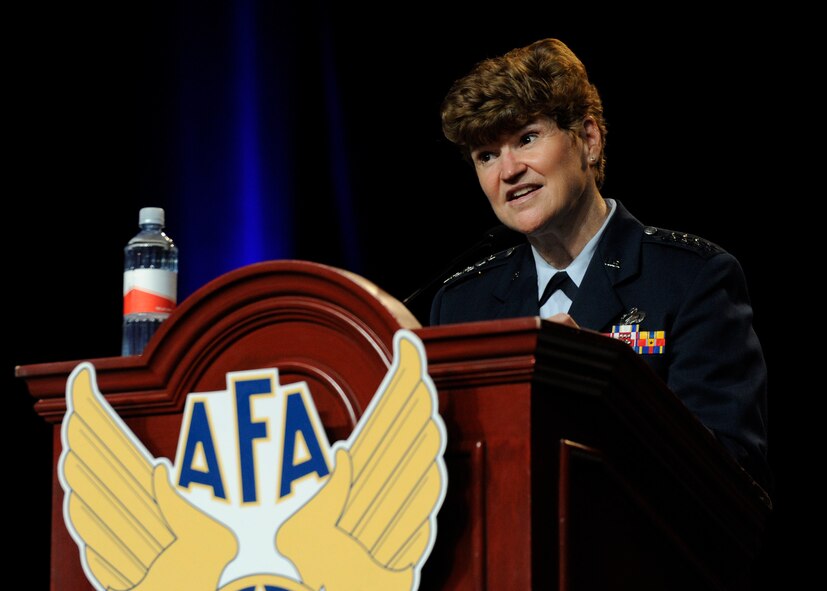WASHINGTON (AFNS) --Improved sustainment of service weapon systems tops
the list of command accomplishments after a year-long reorganization
effort, the Air Force Materiel Command’s top general said here Sept. 16.
Gen. Janet Wolfenbarger addressed her command’s mission of
regaining acquisition excellence in a time of fiscal constraint at the
Air Force Association’s 2013 Air & Space Conference & Technology
Exposition.
“Our mission, as we have embraced it, is to equip the Air
Force for world-dominant air power,” Wolfenbarger said. “In essence we
are responsible for providing combat capabilities to the warfighter and
that is an awesome responsibility the men and women of Air Force
Materiel Command execute on a daily basis.”
Representing 83,000 military and civilian service members
in her command, Wolfenbarger outlined the progress of an ongoing
restructure effort of AFMC’s operations and procedures.
By reducing 12 centers to five, aligned around the primary
mission areas of science and technology, life cycle management,
developmental test and evaluation, and sustainment, command leaders have
improved AFMC processes, Wolfenbarger said.
“(We have) done a lot of work to launch us on a path that
leverages a reorganization that is historic in nature,” Wolfenbarger
said. “What I’m most excited about in this reorganized Air Force
Materiel Command is not how much more efficient we’ve gotten, but how
much more effective we’ve become.”
The command’s five centers are the Air Force Research
Laboratory and the Air Force Life Cycle Management Center, both
headquartered at Wright-Patterson AFB, Ohio; the Air Force Test Center,
headquartered at Edwards AFB, Calif.; the Air Force Sustainment Center,
headquartered at Tinker AFB, Okla.; and the Air Force Nuclear Weapons
Center, headquartered at Kirtland AFB, N.M.
Part of the new organization’s success, Wolfenbarger said,
is the implementation of integrated life-cycle management -- reducing
“seams” in the organization through standardization and streamlining of
processes.
“The real power of the new construct is our ability to work
across the centers to ensure that while they have their own distinct
mission, we can better succeed by working collaboratively,” she said.
“We are looking for standardization and cost-cutting opportunities that
take the construct of ILCM to a level we have never seen before in our
U.S. Air Force. True ILCM is the enabler for delivering affordable and
effective global vigilance, global reach and global power to our
nation.”
Despite the importance of the civilian workforce for AFMC,
Wolfenbarger said in the wake of sequestration her command was able to
maintain support to the most important mission sets.
“We had to slow down some of the great momentum we have
had, during the furloughs,” she said. “We are now ramping back up again,
but it will take us some time – we’re estimating until the second
quarter of fiscal year 2014, to get back to that pace we were on before
the furloughs -- but that hinges on not having to embrace additional
civilian furloughs in fiscal year 2014.”
During fiscal shortfalls, maintaining existing fleets is an
important challenge the Air Force successfully continues to manage, she
said.
“We are very good at maintaining legacy aircraft,” the
general said. “We, along with our industry partners, can continue to
maintain these systems for the length of time our nation demands. But I
have to tell you -- they are not necessarily up to the threats that are
evolving.”
Despite the hardship, Wolfenbarger said there is excitement
within AFMC for the opportunity to standardize approaches, continually
improve them, and to enable the workforce to have a role in a different
way of accomplishing the workflow.
“There is always an opportunity to get better,” she said.
“We’re executing in this new organizational construct for about a year
now and are about 10 days from declaring full operational capability.
But we are all appreciative of the fact that we are on the forefront of
really leveraging this new organizational construct and what it can
provide in terms of a more effective way of executing our mission.”
In an address to civilian leaders within the audience,
Wolfenbarger asked industry partners to also examine their own
approaches of executing military contracts while reducing
inefficiencies.
“Maintaining our national defense comes down to a concerted
collaborative partnership between government and industry,”
Wolfenbarger said. ”Our Air Force partners with industry on identifying
and implementing best business practices and on developing technologies
and weapons systems across the life-cycle management, testing and
sustainment arenas ... Collectively, it is our responsibility to squeeze
as much as we can out of every defense dollar that’s allocated to us.”
While the current budgetary environment provides a
significant opportunity to reinforce the role of industry and military
in this partnership, Wolfenbarger said smaller budgets will require all
to bring even more ingenuity, creativity and collaboration to the table.








No comments:
Post a Comment